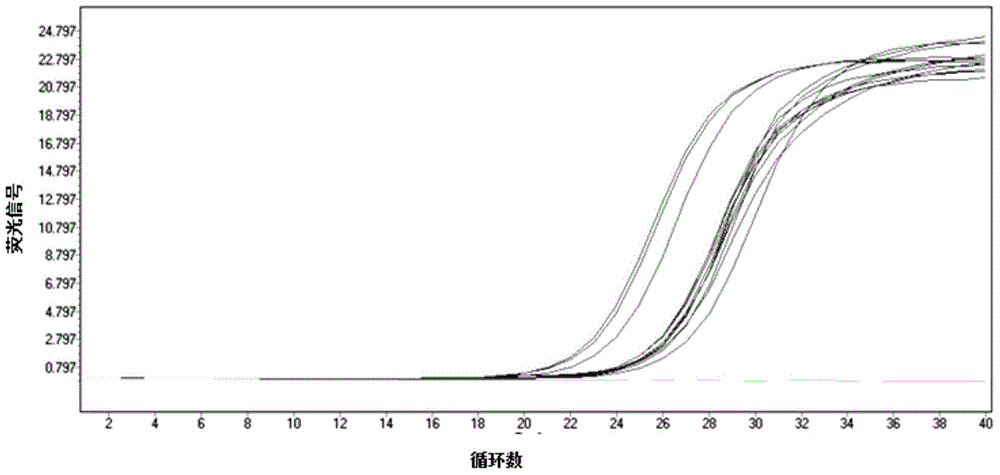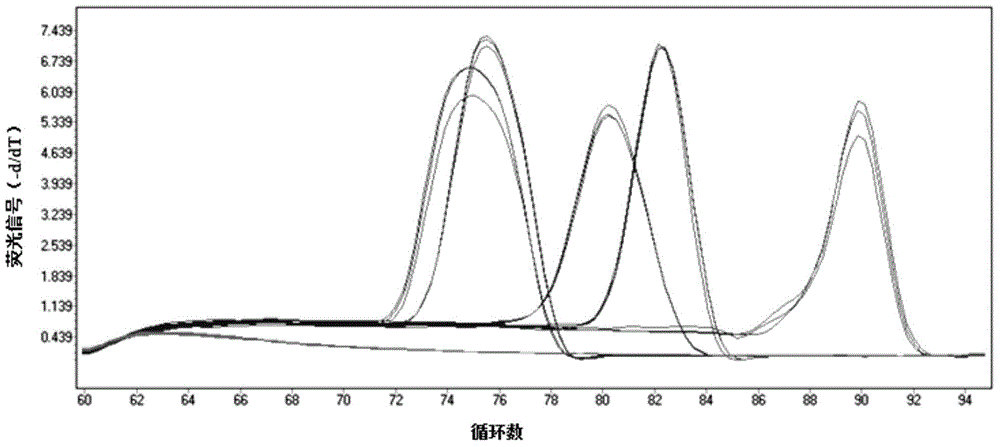Transgenic soybean GTS40-3-2 and endogenous and exogenous gene multi-nested fluorescent quantitative PCR (polymerase chain reaction) detection primer combination method
A genetically modified soybean and fluorescent quantitative technology, which is applied in biochemical equipment and methods, microbial measurement/inspection, recombinant DNA technology, etc., can solve the problems of low detection throughput and unstable reaction, and achieve the effect of high sensitivity
- Summary
- Abstract
- Description
- Claims
- Application Information
AI Technical Summary
Problems solved by technology
Method used
Image
Examples
Embodiment 1
[0060] (1) Extraction of DNA
[0061] The DNA of the transgenic soybean GTS40-3-2 sample (purchased from Shantou Entry-Exit Inspection and Quarantine Bureau) was extracted by kit method (Wizard Genomic DNA purification kit, A1120, Promega).
[0062] (2) Multiple nested fluorescent quantitative PCR
[0063] First round of multiplex PCR. The reaction system contains 25 μL of A solution, 0.25 μL of DNA polymerase, 10.5 μL of primer solution, 50 ng of sample DNA to be tested, and ddH 2 O to make up to 50 μL. The first round of multiplex PCR reaction conditions: 94°C for 5min; 94°C for 30s, 60°C for 30s, 72°C for 90s, 15 cycles; 72°C for 5min; the specific number of cycles can be adjusted within the range according to the actual situation. After the first round of multiplex PCR reactions, ddH 2 O dilute the PCR product 100 times;
[0064] The second round of fluorescent quantitative PCR. The reaction system contains 12.5 μL of solution B, 0.2 μL of DNA polymerase, primer solu...
Embodiment 2
[0067] Using the identification method of Example 1, the isolated and purified transgenic soybean GTS40-3-2, A2704-12 (purchased from Shantou Entry-Exit Inspection and Quarantine Bureau), transgenic corn Bt11, T25 (purchased from Shantou Entry-Exit Inspection and Quarantine Bureau), Transgenic rapeseed RT73 (purchased from Shantou Entry-Exit Inspection and Quarantine Bureau) and non-transgenic soybean (Hefeng 25, purchased from Soybean Research Institute of Northeast Agricultural University) were identified.
[0068] The results are shown in Table 1, which shows that only the soybean endogenous gene lectin is positive in non-transgenic soybeans; all five genes of transgenic soybean GTS40-3-2 are positive; transgenic soybean A2704-12 has soybean endogenous gene lectin and CaMV35S promoter These two genes are positive; transgenic maize T25 has a gene of CaMV35S promoter which is positive; transgenic Bt11 has two genes of NOS terminator and CaMV35S promoter which are positive; tra...
Embodiment 3
[0072] GTS40-3-2 genetically modified soybeans and non-transgenic soybeans (Hefeng 25, purchased from the Soybean Research Institute of Northeast Agricultural University) were used to prepare samples with GM contents of 100%, 10%, 1%, 0.1%, and 0.01% according to the mass ratio. , using the identification method of Example 1 to analyze the NOS terminator gene. Also refer to the primers and probes of the NOS terminator gene in SN / T1204-2003:
[0073] Upstream primer: ATCGTTCAAACATTTGGCA (SEQ ID No: 21);
[0074] Downstream primer: ATTGCGGGACTCTAATCATA (SEQ ID No: 22);
[0075] Probe: FAM-CATCGCAAGACCGGCAACAGG-BHQ1 (SEQ ID No: 23); wherein, FAM is a fluorescent group, and BHQ1 is a quencher group.
[0076] The results show that ordinary fluorescent quantitative PCR can detect samples with a transgene content of 0.1%, while multiplex nested fluorescent quantitative PCR can detect samples with a transgenic content of 0.01%, which is higher than the common fluorescent quantitativ...
PUM
 Login to View More
Login to View More Abstract
Description
Claims
Application Information
 Login to View More
Login to View More - R&D
- Intellectual Property
- Life Sciences
- Materials
- Tech Scout
- Unparalleled Data Quality
- Higher Quality Content
- 60% Fewer Hallucinations
Browse by: Latest US Patents, China's latest patents, Technical Efficacy Thesaurus, Application Domain, Technology Topic, Popular Technical Reports.
© 2025 PatSnap. All rights reserved.Legal|Privacy policy|Modern Slavery Act Transparency Statement|Sitemap|About US| Contact US: help@patsnap.com



